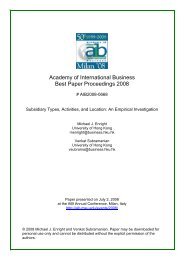AIB 2012 Conference Proceedings - Academy of International ...
AIB 2012 Conference Proceedings - Academy of International ...
AIB 2012 Conference Proceedings - Academy of International ...
You also want an ePaper? Increase the reach of your titles
YUMPU automatically turns print PDFs into web optimized ePapers that Google loves.
TUESDAY<br />
This paper examines how the Hyundai Motor Company (HMC) became a global automaker through its Foreign<br />
Direct Investment (FDI) experience in India. HMC outperformed its competition through its rapid and aggressive<br />
expansion into foreign markets to become a major global automaker in a short period <strong>of</strong> time despite its limited<br />
international experience. We study HMC's previous FDI strategies and practices and examine how the lessons<br />
learned from its failed investment in Canada enabled it to overcome the challenges <strong>of</strong> establishing its operations<br />
in India. This paper also analyzes the reasons for HMC's success in India and how its experience can be imitated<br />
by other companies whose home countries are at a similar stage <strong>of</strong> development as that <strong>of</strong> Korea's or at the<br />
emerging market status. HMC's approach to the Indian market can be dubbed as a "Queen Bee" colonization<br />
strategy. The practical implications <strong>of</strong> HMC's FDI strategy are also discussed. (For more information, please<br />
contact: Hyeong-Deug Kim, Simon Fraser University, Canada: hdkim@sfu.ca)<br />
Perspectives on Chinese Foreign Direct Investment in Australia<br />
Robert Graham Jack, Macquarie University<br />
Lijun Qin, Macquarie University<br />
Monica Ren, Macquarie University<br />
The sheer size and scale <strong>of</strong> China's internationalisation, and its significance for Australia's future trade and<br />
investment relations, encourages analysis <strong>of</strong> its overseas investment modes and strategies. By employing an<br />
exploratory, multiple case study methodology, across a diverse range <strong>of</strong> Chinese manufacturers in the<br />
Australian market, we seek to contribute to the literature on firm internationalisation from emerging markets as<br />
well as enhancing our understanding <strong>of</strong> firm strategies from one <strong>of</strong> Australia's most important trading partners.<br />
Four key research questions, drawn from an overview <strong>of</strong> the relevant literature, are presented. These questions<br />
focus on the reasons why Chinese firms target the Australian market; their choice <strong>of</strong> entry mode, and the value<br />
creating activities they locate in Australia. Among the key findings from our research is the use <strong>of</strong> the<br />
Australian market by Chinese firms for new product testing and the ongoing challenges these firms face in<br />
building brand preference for their products. (For more information, please contact: Robert Graham Jack,<br />
Macquarie University, Australia: rob.jack@mq.edu.au)<br />
Are Mining Firms Just <strong>International</strong>izing for Natural Resources The Motives <strong>of</strong> Chinese Mining SOEs and POEs<br />
Monica Ren, Macquarie University<br />
Robert Graham Jack, Macquarie University<br />
We present six comparative case studies detailing the outward foreign direct investments (OFDI) <strong>of</strong> three<br />
Chinese mining state-owned enterprises (SOEs) and three private-owned enterprises (POEs) to examine their<br />
motives for internationalization. Case studies indicated that their motives fulfill multiple aims and are multidimensional.<br />
Both mining SOEs and POEs have unique ‘domestic comparative ownership advantages'. While the<br />
SOEs internationalize to exploit competitive advantages, the POEs move abroad to redress competitive<br />
disadvantages. This exploratory study suggests that POEs are not yet internationalizing to gain global<br />
competitiveness, but to sustain or improve their existing positions in the Chinese mining industry. (For more<br />
information, please contact: Robert Graham Jack, Macquarie University, Australia: rob.jack@mq.edu.au)<br />
Foreign Acquisitions by Emerging Country Multinationals: Asset Exploitation or Asset Augmentation<br />
Surender Munjal, University <strong>of</strong> Leeds and University <strong>of</strong> Delhi<br />
Peter Buckley, University <strong>of</strong> Leeds<br />
Nicolas Forsans, University <strong>of</strong> Leeds<br />
Peter Enderwick, Auckland Technical university<br />
Since the last decade, we witnessed a rise in the internationalisation <strong>of</strong> multinationals enterprises from the<br />
emerging markets (EMNEs). The traditional perspective <strong>of</strong> internationalisation puts forward asset exploitation as<br />
prime driver for internationalization. However, asset augmentation was further acknowledged as a determinant<br />
<strong>AIB</strong> <strong>2012</strong> <strong>Conference</strong> <strong>Proceedings</strong><br />
Page 211

















